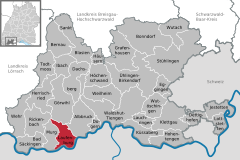Laufenburg, Germany
Laufenburg | |
|---|---|
 View from CH-Laufenburg to D-Laufenburg. | |
Location of Laufenburg within Waldshut district  | |
| Coordinates: 47°33′56″N 08°03′53″E / 47.56556°N 8.06472°E | |
| Country | Germany |
| State | Baden-Württemberg |
| Admin. region | Freiburg |
| District | Waldshut |
| Subdivisions | 8 Stadtteile |
| Government | |
| • Mayor (2016–24) | Ulrich Krieger[1] |
| Area | |
• Total | 23.58 km2 (9.10 sq mi) |
| Elevation | 337 m (1,106 ft) |
| Population (2022-12-31)[2] | |
• Total | 9,136 |
| • Density | 390/km2 (1,000/sq mi) |
| Time zone | UTC+01:00 (CET) |
| • Summer (DST) | UTC+02:00 (CEST) |
| Postal codes | 79725 |
| Dialling codes | 07763, 07753 |
| Vehicle registration | WT |
| Website | www.laufenburg.de |
Laufenburg is a town in Baden-Württemberg, Germany, part of the Waldshut district. It has approximately 4300 inhabitants (including 6 outskirts 8300 inhabitants). Laufenburg is separated from a Swiss city with the same name by the river Rhine.
Cities in the near vicinity
- Near surrounding (<15 km): Bad Säckingen, Waldshut-Tiengen, Rickenbach (Hotzenwald), Albbruck, Murg am Hochrhein, Stein AG
- Further away (>15 km): Lörrach, Basel, Brugg, Aarau, Zürich, Schaffhausen, St. Blasien, Todtmoos, Freiburg
City administration
The city of Laufenburg encompasses also Binzgen, Grunholz, Hauenstein, Hochsal, Luttingen, Rhina, Rotzel, Stadenhausen.
Brief history
The city was first noted in 1207. In November 1638 one side of the city was taken by Imperialist forces. The bridge across the Rhine was burned afterwards.
Laufenburg was one city until about 1800 when Napoleon divided the city, ordering that the Rhine should become the border. Ever since the two cities have been separated by nationality. The city was well placed on major rapids of the Rhine, which allowed the town to collect taxes as well as catch salmon. In the early 20th century the rapids were demolished in order to build a hydroelectric power plant.
Bridge construction
In December 2004 a new bridge was opened to the east of the city, replacing the previous bridge which had become too congested, because the roads connecting the bridge were single lane roads but were being used for two way traffic. With the opening of the new bridge a new shopping development was erected to the east of the town.
Its construction was hampered by a major engineering mistake. For reasons of politics and budgets, Switzerland and Germany each constructed half the bridge, rather than one unified contractor doing everything. The half-bridges needed to align precisely on height. Switzerland and Germany use different references for sea-level: the Mediterranean Sea and North Sea respectively. The result is that height above sea level differs by 270 millimetres (0.89 ft) between the two references. This quirk was known to the engineers and they accounted for it, but the calculations made a sign error. Rather than cancelling out this known difference, it instead doubled it to 540 millimetres (1.77 ft).[3][4]
References
- ^ Aktuelle Wahlergebnisse, Staatsanzeiger, accessed 15 September 2021.
- ^ "Bevölkerung nach Nationalität und Geschlecht am 31. Dezember 2022" [Population by nationality and sex as of December 31, 2022] (CSV) (in German). Statistisches Landesamt Baden-Württemberg. June 2023.
- ^ The Metric Maven (30 March 2017). "A Bridge Too Far?". Retrieved 23 December 2022.
- ^ "What Happens To A Bridge When One Side Uses Mediterranean Sea Level And Another The North Sea?". Science 2.0. 2 October 2013. Retrieved 23 December 2022.
External links




